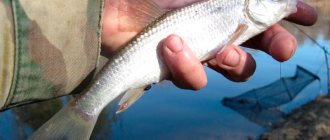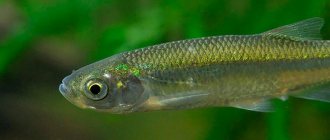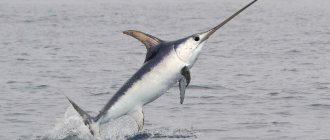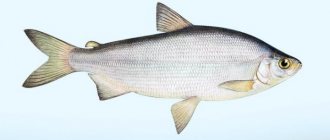Shamaika fish or shemaya is widely distributed in the Black and Azov Seas, has excellent taste and is a favorite fishing item for professional and amateur fishermen. Intensified fishing for this species led to its almost complete extinction; in 2006, the shemaya was included in the Red Book, which did not stop poachers from continuing to catch it.
Shemaya, also called the “royal” fish, belongs to the carp family, but it also has its own characteristics. The Azov shamaika has the following characteristics:
- The fish that is caught in the Black Sea is larger in size than its relatives from the Azov Sea. In some cases, shemaya grows up to 900 grams, which makes such individuals trophy, since usually its weight does not exceed 200-300 grams.
- It has an oblong body, covered with small scales with a silvery color.
- The head of the fish is small, its color is darker than the body with a bluish tint.
- The lower jaw protrudes forward and is noticeably thickened.
- The eyes are silver in color and have a black dot at the top.
- The belly of the fish is white, gradually turning gray towards the back.
- The anal and dorsal fins are darker in color, close to black, while the rest are gray.
Gallery: shamaika fish (25 photos)
Habitat
Previously, shamaika fish was widespread, but now the places where it is possible to find it can literally be counted on one’s fingers. Since it can live in both fresh and salt water without any problems, its habitat includes various types of reservoirs:
Where is the sabrefish fish found?
- The main concentration of this fish is observed in the Azov, Caspian and Black Seas. From these it flows into adjacent rivers and freshwater bodies.
- The rivers Don, Dnieper and Dniester, the population of shamaika in which is much smaller than in the seas.
- Aral Sea. For some reason, it is in this reservoir that large specimens of king fish are predominantly found.
- In Europe, small concentrations of shamaika are present in the Danube, as well as in several reservoirs in Bavaria.
- Lower reaches of the Terek and Kura.
The king fish does not like to go high upstream, so even in rivers its maximum concentration is observed closer to the mouth, in sea basins. In addition, there are two types of shamaika: residential and semi-through. The first lives exclusively in rivers, while the second prefers salt water and lives mainly in the seas, leaving them only during the spawning period.
Nutrition, reproduction and lifestyle of shamaika
The lifestyle of the fish depends on the population and habitat of the species:
We also recommend reading:
Bleak fish: description of where buckle, sintya, and whitefish live List of fish: whitefish species muksun, omul and vendace Smelt fish: benefits and harms, habitat, preparation Who is whitefish?
- Shemaya, which breeds in Bavaria, prefers reservoirs with clean water and a rocky bottom.
- On Russian territory, it rarely leaves the seas; it rises into rivers only during the spawning period.
- Due to the fact that this species prefers rivers with fast currents, the shemaya does not live in the Volga basin, and it can rarely be caught in the Dnieper. In rivers such as the Kuban and Terek, its population is much higher.
Shemaya is an omnivorous fish and its diet consists of various types of insects, crustaceans and plankton. Sometimes it can eat fry.
This species begins to reproduce after reaching 2 years of age. Spawning occurs in the warm waters of rivers into which the fish rises from the sea; spawning occurs most often at night. Since the fish prefers places with fast currents, spawning occurs in places close to riffles with a rocky bottom. The period of ripening of eggs is 3-4 days, but by this time the shemaika has already returned to sea waters.
The young remain in the rivers throughout the whole year, distinguished by a long period of development. Only after this does the new generation move to the sea, where fish growth accelerates due to the expansion of the diet.
Nutrition
Despite its small size, the bleak is quite voracious.
Its main delicacy is flies and other insects, plankton, eggs, larvae, and fry. Sometimes after sunset you can see how a bleak jumps out of the water: first it moves in one direction and the other, then sharply turns over on its side, bends its body, hits the water with its tail and, having described a semicircle in the air, falls back into the water. This technique is aimed at obtaining food: at this time, clouds of mosquitoes and midges swarm near the water, sprayed with water, they fall to the surface, where they become prey for fish. The bleak acts in the same way when it sees a predator, perch, pike or asp, who like to feast on small fish. Read Pike fishing in autumn
Fines for poaching
The Red Book includes shemaika in its list, so the law provides for fines for catching it:
- a real criminal sentence can be obtained for catching this type of fish with nets on a large scale; poachers cannot count on an administrative sentence;
- for catching a female shemai, fines double, ranging from 2,000 to 5,000 rubles, but this applies to ordinary people;
- officials pay much larger sums for fish; fines for them range from 10,000 to 15,000 rubles and are constantly growing.
Shemaya is a fish with a unique taste, the analogue of which can be considered northern grayling. Despite significant fines, its fishing continues in its habitats, reducing the population of this unique fish every year.
Nature conservation
Fishing for shamaika is currently a very, very expensive activity - due to the rapid decline in numbers, it is included in the Red Book of Russia, as well as some regions. Thanks to its tender meat, it has long been the main target of fishing for both local residents and fishing enterprises, as well as tourists. For this reason, by 2007, its population had declined so much that the fish practically ceased to be found in its natural habitat, where it was previously widespread.
After that, its fishing was prohibited, fines for its illegal catch amounted to 2 thousand rubles per head, and for catching in large quantities it became quite possible to face criminal prosecution. However, quite active fishing continues to this day, despite laws and prohibitions. The reason for this is its high demand on black markets, where its cost sometimes exceeds the price of sturgeon.
Read: Correct assembly of feeder gear
Since 2014, attempts have been made to restore the population of this valuable fish, for which purpose in the Rostov region, in specialized nurseries, fry were bred, which were subsequently released into natural habitats. In 2014, their number was 3 million and has continued to grow since then.
To catch the royal fish, a simple fisherman will have to pay from two thousand rubles per head. In the case of using nets and other prohibited gear to catch large quantities of shamaika, even an individual may face a real prison sentence.
Despite the fact that fines for legal entities can exceed a million rubles, poaching of this fish has not yet been defeated.
Shamayka fish
Shamayka or shemaya is a prominent representative of the basins of the Azov and Black Seas. This fish is incredibly tasty, so for a long period it was caught in large quantities by both local fishermen and visitors.
A group of fishermen revealed the name of the secret bait during interrogation.
Category: regional news.
Such uncontrolled fishing of this fish led to the fact that by 2006-2007 the number of this fish had decreased significantly and it was almost impossible to find it in its usual habitat. As a result, shamaika was included in the Red Book. Despite the protective actions of the law, poachers and local fishermen still continue to fish for this rare and tasty fish.
Why was shamaika called the “royal fish”?
Fines
Since shamaika is listed in the Red Book, there are prohibitions and penalties for catching it. For example:
- Fishing, in especially large quantities, especially with the use of nets, may entail not administrative, but criminal punishment. In this regard, you should expect to receive either a suspended or a real prison sentence.
- Catching individual individuals by ordinary citizens will entail fines ranging from 2 to 5 thousand rubles. The size of the fine depends on the number of fish caught. If females are present in the catch, the actual fine may double. At the same time, it must be taken into account that the amount of fines increases every year.
- If single specimens are caught by officials, the fine may range from 10 to 15 thousand rubles. As an example, a precedent can serve when one Krasnodar businessman was found in possession of a shamaika and he was fined for an amount significantly exceeding the indicated figures.









